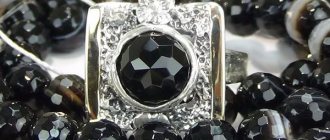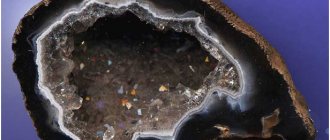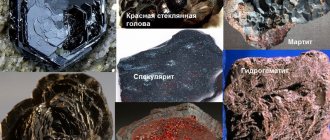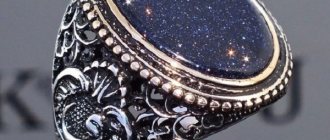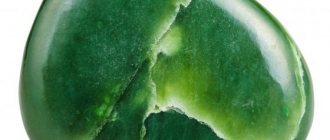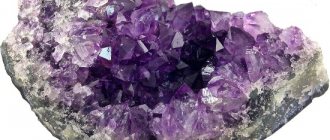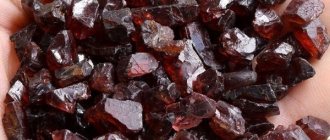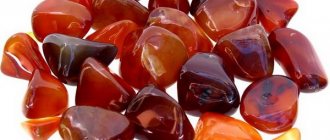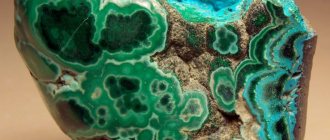How opalite was discovered
Opalite is an artificial glass stone.
Natural opals and moonstones of jewelry quality without defects and chips are quite rare in nature, so the cost of such minerals is high. This gave impetus to studying the possibilities of producing artificial analogues. The first attempts were made in Ancient Rome. In those days, the technology for making glass products was imperfect. The first high-quality imitation of opal in laboratory conditions was obtained in 1972 by Pierre Gilson.
Now opalites are produced in:
- Switzerland;
- USA;
- Japan;
- China;
- India;
- France.
The technology for making such gems is constantly being improved. Nowadays, in the production of stones, special opal glass with the addition of calcium phosphate, aluminum and sodium fluoride, calcium fluoride, etc. is used. The material is painted evenly. In addition, the resulting specimens are carefully polished with sugar paste.
How to spot a fake?
You can often find fake moonstones on sale. This is due to the gradual depletion of valuable mineral reserves in the deposits of Sri Lanka, the USA, Mexico and other countries of the world. Glass or plastic is used to produce artificial opalite. Every year, technologies for manufacturing unnatural semi-precious stones become more and more advanced. The majority of such products come from India.
You can distinguish a natural moonstone from a fake in the following ways:
- Real opalite looks less bright compared to artificial opalite; shining highlights in the mineral appear when viewed from a certain angle.
- By turning the stone along its axis, you can observe a change in the play of light refracted in its layers. The radiance of artificial opalite does not change when the position of the gem changes. Its highlights are sharper and more geometrically defined.
- Moonstone is associated with the element of Water, so it is enough to hold the mineral in it for several hours to enhance the brightness of its tints. A fake product does not change its properties after immersion in water.
- The surface of opalite is silky in appearance, the stone is cold to the touch and takes a long time to heat up in your hands.
- When viewed in the light, even stripes are sometimes visible on the sides of the artificial moonstone at the junction of layers of material. And also, against the background of the upper, lighter and more transparent layers, a darker colored substrate can stand out.
- In synthetic opalite that has undergone high-temperature treatment, under a microscope, and in some cases with the naked eye, small cracks filled with air bubbles are detected.
- The buyer should be wary of the low cost of the mineral - the price of natural moonstone is not inferior to prices for gold products.
- The color of natural adularia is not deep pink, blue or green.
The most accurate way to verify the authenticity of a mineral is gemological examination in laboratory conditions.
Appearance of moonstone
Now manufacturers produce opalites of all colors. The line includes both samples that imitate natural stones and samples of unusual shades. Their peculiarity is the optical light effect that occurs due to the refraction of rays when they are reflected from particles of additives present inside the glass.
Color variations
In the classification used in jewelry, there are the following color groups of opalites:
- Black - all specimens of dark shades, incl. dark green, blue, black, etc.
- Pink - pink and yellow-orange opalites.
- "Harlequin" - specimens of white and blue shades with iridescence and a characteristic glow.
- "Dragon's Breath" - transparent bright red samples.
- “Sea” - opalites of blue-green shades.
- "Oxblood" - opaque red specimens.
Opalite comes in different shapes, colors and sizes.
How to distinguish natural stone
It is incorrect to consider opalite as a fake of opal and moonstone. The gem obtained in laboratory conditions is an independent semi-precious crystal. However, passing off opalite as natural opal is a scam. There are a number of parameters that allow you to distinguish between these gems.
The naturally occurring mineral has a layered structure, which results in light being reflected at different angles. This creates the effect of sunbeams inside the sample. Reflections can be of different colors. Opalites have a uniform glow. A similar effect occurs due to the homogeneity of the structure.
To verify the authenticity of a stone, X-rays are often used. Under this influence, a white-violet light emanates from the opal. Opalite does not have such an effect.
To determine whether a stone is natural, you can use a magnifying glass. When magnified, the layered structure is clearly visible.
To determine natural opal, a water test is often used. In this environment, the natural gem will become brighter, and the artificial one will fade. Opalite is characterized by greater thermal conductivity. Glass heats up faster than natural gemstones. Natural opal must have a certificate of conformity. This document indicates the name of the mineral, as well as its country of origin.
You can check the authenticity of a gem using water.
Physicochemical characteristics
Opal is amorphous silica, devoid of a crystal lattice. Semi-precious jewelry stone.
The color of opal varies, but all types have a common characteristic: pearlescent luster. The effect in which the glow comes from inside the stone and scatters across the surface is named after the stone - opalescence . Applies to other precious minerals.
Opals can be transparent or translucent. This determines the percentage of water in the stone: the more, the more transparent the gem. For noble people it’s strictly 6–10%.
| Formula | SiO2 nH2O |
| Color | White, yellow, red, orange, brown, blue, green, black |
| Shine | Glassy, dim, sometimes pearlescent |
| Transparency | From transparent to translucent |
| Hardness | 5,5 — 6,5 |
| Cleavage | Absent |
| Kink | Conchoidal; fragile |
| Density | 1.96 - 2.20 g/cm³ |
Who is the stone suitable for?
Products with stones must be selected taking into account individual compatibility. To determine it, you should take into account your date of birth, name and zodiac sign.
By name
If the opalite is compatible with the owner's name, it will bring good luck and have a positive effect on the person's health. The stone compensates for missing character traits and minimizes negative personality traits.
Opalite is well suited for owners of the following names:
- Irina;
- Anastasia;
- Olesya;
- Elena;
- Ruslan;
- Novel.
Names of people with whom Opalite is compatible.
Horoscope
Opalite is compatible with all zodiac signs belonging to the element of Water. It suits Scorpios, Cancers, Aquarius and Pisces well. For people born under these signs, the stone will become an emotional balancer. The gem will relieve anxiety and worries. Virgos will also benefit greatly from contact with opalite. The stone will help you find love and create a strong family. Wearing jewelry with opalite is recommended for Libra. The gem will help people of this zodiac sign to reveal their talents.
Which zodiac signs does opal suit?
Astrologers consider Opal to be the stone of the Moon. Regarding the distribution of opals by zodiac sign: Sagittarius and Taurus can wear fire opals, as well as emotional representatives of the Scorpio sign. The latter are also the only sign who can wear black opal, which is especially contraindicated for Taurus.
Delicate gems can also be worn by Libra and Aquarius.
White opals remain neutral: these stones can be worn by any zodiac sign, but especially by bright and emotional people.
What does scorch stone cure?
It is believed that contact with opalite helps eliminate stress and chronic inflammatory processes. In addition, this gem, in combination with other traditional medicine, helps a person get rid of nervous tension and reduces the risk of emotional breakdowns. In people suffering from epilepsy, contact with opalite reduces the number of seizures. The gem relieves nightmares and improves sleep quality.
Opalite improves night sleep.
Opalite has a beneficial effect on the condition of the digestive and urinary systems. Contact with this stone prevents the formation of kidney stones. The gem helps eliminate inflammatory diseases of the respiratory tract. In addition, it reduces the severity of asthma symptoms. Opalite has a beneficial effect on hematopoietic processes and improves hormonal levels.
Jewelry with a gem is recommended for pregnant women. This will have a beneficial effect on the course of pregnancy and will facilitate the birth process.
Lotus nectar and sacred cow milk
Cacholong stone has been known since ancient times. Many peoples have legends about the origin of the mineral.
The Egyptians considered the gem to be the stone of the sacred bull Apis.
In the Roman Empire, stone was used as an ornamental stone and used to decorate interiors.
For the Mongols, kacholong is the petrified nectar of the sacred lotus flower.
Hindus consider the mineral to be the milk of a sacred cow transformed into white cacholong.
The Chinese created the best porcelain. A collectible piece of a snow-white translucent stone was placed in a place where porcelain treasures were stored. The similarity between the untouched whiteness of the stone and the porcelain, as thin as the petals of a flower, spoke of wealth.
The most poetic version: cacholong - moonlight turned into stone.
What's in a name
The name kacholong, or kahcholong, comes from Kakh - a river in the Kalmyk steppes; cholong - stone.
The cacholong mineral has several names:
- Kalmyk agate;
- pearl opal;
- Kalmyk pearls;
- Kohalong agate;
- half-fallen
Magical properties of the stone
Esotericists believe that the Moon gives opalite its magical power. The gem is able to enhance the spiritual component of the owner and attract material wealth. The energy of the stone increases during the full moon and decreases during the darkening of the moon.
The spiritual component of the owner
Artificial moonstone is a powerful amulet that protects against damage and other negative magical effects. Opalite enhances a person's creative abilities and helps to find inspiration. The stone has a beneficial effect on character traits, reducing aggressiveness and temper.
Contact with a gem helps to find peace of mind and moderate arrogance. In addition, under the influence of this stone a person becomes more kind and tolerant of others. Opalite is used in spiritual practices and meditation.
The stone is recommended to be used during meditation.
Material wealth
The gem helps a person concentrate on performing work duties. This contributes to rapid advancement on the career ladder. Opalite attracts good luck. For people involved in business, the gem will help them make useful contacts.
Opalite attracts material well-being. Under the influence of the gem, a person will successfully invest money. When contacting a stone, there is a high probability of receiving unexpected material benefits from distant relatives.
Relationships and love
For single people, the gem will help them meet their other half. The influence of opalite helps improve family relationships. Spouses, even after a long period of resentment and quarrels, will come to mutual understanding.
The flickering of opalite contributes to the emergence of common goals and interests between men and women. This will revive old feelings and bring passion back into the relationship. It is believed that artificial moonstone protects against betrayal and betrayal in the family.
Where are beautiful stones mined?
Opals are classified according to their method of origin. There are 2 possible types of genesis:
- Sedimentary stones are formed during physical and chemical processes occurring in the earth's crust. Australian opal belongs to this variety.
- Hydrothermal rocks form when magma cools and crystallizes. This group includes the beautiful Ethiopian opal.
ALORIS gold ring with peridot, cubic zirconia and opals (go to the SUNLIGHT catalogue)
The most beautiful gems can be found all over the world. At different times they were mined in different parts of the world. Deposits were found in the Czech Republic, India, and Hungary. Today, pebbles are mined in Mongolia, Indonesia, the USA, Brazil, and Turkey. And the most popular are gems mined in two countries:
- Australian opal has a unique, simply enchanting beauty. The largest deposits are located on the continent; approximately 95% of the world's mineral reserves are concentrated there. The natives believe that the Creator himself gave them such a generous gift. One day he descended from heaven to bestow the highest knowledge on humanity. Where the Creator stepped, beautiful shining stones immediately appeared. They were opals. The scientific version of the origin of gems is less prosaic. According to it, millions of years ago, when the territory of the continent was covered by numerous sea lagoons, sedimentary rocks, remains of animals and water enriched with silicon accumulated in their voids. It was they who contributed to the birth of minerals.
- Ethiopian stones are formed in basalt and rhyolite rocks. The stones fill numerous cracks and veins. Most of the crystals have light shades: yellowish, gray, white, light orange. Much less common are saturated fiery, orange, golden-red colors. The real highlight of the species is the chocolate mineral. As the name suggests, it has a deep brown tint. And the most valuable are the noble species, which are distinguished by high transparency and rich play of light.
Japanese gems are especially original. Their peculiarity is that such samples are not obtained in the natural environment, but are grown in laboratories. Artificial and natural minerals are practically no different from each other. In any case, a non-professional will definitely not detect the difference. However, man-made opalite has brighter, more saturated shades. The variety of stone colors is amazing.
How to choose talismans and amulets with opalite
It is better to buy rings and earrings with opalite as a talisman. Being on the owner’s hand, the gem will attract good luck to business and make all of a person’s undertakings profitable. Wearing earrings with this stone eliminates unnecessary thoughts, helping you concentrate on your goals. Such a talisman will eliminate unnecessary doubts and help you find happiness in your personal life. It is better to use pendants made of silver with opalite as an amulet. The product will protect a person from any negative magical effects. The amulet will help get rid of hidden ill-wishers.
Jewelry with opalite gives the owner luck and prosperity.
Synthetic and laboratory opal. Imitations
It is always worth remembering that whether you are presented with an Australian opal or a stone found in Japan, the beautiful sparkle and play of light may not be genuine and the opal may be synthetic.
In the 1970s, the Gilson Company developed a three-step process for creating convincing synthetic opal. First, deposition creates microscopic spheres of silica. The balls are then left to sit in acidic water for more than a year. Finally, a hydrostatic press brings the spheres together without distorting the folded structure, creating a play of opal color.
Advertising - Continued below
However, you shouldn’t get upset right away: often artificial opal can be a good alternative to natural stone. Its obvious advantages are greater resistance to external influences and lack of reaction to too low air humidity, from which natural opals suffer so much. Today they have learned how to make synthetic opals of really high quality and their extraordinary iridescence looks very impressive. At the same time, the difference in price can be truly colossal.
How to distinguish real from fake
There are several techniques that will allow you to distinguish natural opal from artificial opal with a fairly high probability. Among them:
- testing for adhesion to the tongue (natural stone does not stick),
- checking for glare under sunlight (the original glows in the hands with a beautiful palette of shades),
- checking for bubbles under a magnifying glass (they cannot be in natural opal) and some others.
Read more about them in the article on how to identify real opal.
Opals are sometimes impregnated with paraffin or synthetic lubricants to improve brilliance and stability. Raw opal in the gemstone category is usually sold in buckets of water to enhance the play of color that is visible when the opal is wet.
Care and wear of opalite
Opalite is a fairly fragile material, so products with it must be worn carefully. A fall or other accidental mechanical impact can lead to chips and cracks. In addition, this gem is not resistant to household chemicals and temperature changes. It is necessary to avoid prolonged exposure of the stone to direct sunlight.
Opalite requires careful care. Approximately once every 2 weeks, wash the product in warm soapy water and rub with a soft velor cloth. It is better to store such jewelry in a fabric case.
What does it look like and where does it live?
Opalite is one of the most mysterious gems, the color range of which ranges from white to black. The stone has thin plates, thanks to which radiant shimmers of bluish or light blue color are created. Exceptional specimens may have a golden or reddish hue. Opalite is fragile and soft, so even minor impacts can damage its surface. The stone is considered semi-precious and is often used in jewelry making.
One of the deposits of the mineral is the Adula Mountains, but opalite can also be found in Austria. The most popular is blue opalite, which is characterized by transparency or a milky sheen. The black stone shimmers in red, orange and bright yellow. The best breeds are found in Myanmar and on the island of Sri Lanka. Gem deposits have also been discovered in the regions of the Russian Federation.
Origin
Many people know opalite under another name, namely adularia, which it received thanks to one of its deposits - the Adul Mountains, located in Switzerland. Opalite is distinguished by its richness and density of shades, which shimmer under the light of the moon, which gives it another name: “moonstone”. The inhabitants of ancient Asia considered this gem sacred and worshiped it.
Petersit
The unusual beautiful stone Petersite is a very rare variety of tiger's eye, which is distinguished by its unusual colors and silky iridescence of colors and highlights. It has a rather exotic yellowish or yellowish-green color scheme. It is highly valued as specimens of this stone are extremely rare.
In folk medicine, Petersite is used for the prevention and treatment of the thyroid gland.
The stone helps concentration and inner enlightenment, which is why Petersite so often becomes an attribute of a meditative session. There is an opinion that the mineral is able to calm inner feelings and relieve stress. Petersite helps its owner achieve inner harmony and balance . The magical capabilities of the mineral manifest themselves in balancing the emotional state of its owner. Petersit can reveal oratory talent in its owner and strengthen his teaching abilities. Regarding zodiac predisposition, the stone is suitable for absolutely all signs.
The magic of procreation
The magic of cacholong is female. This is a powerful amulet for every woman.
The father must give his daughter a product with a gem. So she will always be protected by the power of the great mother Earth. She will help keep the girl clean. For a woman, the mineral will become a faithful assistant in motherhood. She will always have milk for the baby, the stamina to survive sleepless nights. And wisdom, affection, firmness in the fight against the hormonal war of a grown-up child.
The magical properties of cacholong are suitable for people of humanitarian professions.
The energy of the gem will be included in the healer’s work and will help find problems in the patient’s body.
We recommend: ALBITE - “moon” stone
Interesting: a ring with cacholong will help you avoid falling into poverty and even improve the thickness of your wallet.
The magic of cacholong is pure, “white”. The stone does not accept evil deeds so much that in its presence black magic fails.
Types of opals
Opals used to make jewelry can be natural or synthetic. Gemologists, depending on color, composition, and place of origin, identify more than 140 varieties of stone, but they are all divided into 2 large groups.
Noble
Precious opals are stones with a bright iridescence that are of the greatest value to jewelers. Minerals with high decorative qualities can be more expensive than diamonds.
The ability to shimmer with all the colors of the rainbow is due to the structure of the gem. The globules that form the structure of precious rocks have approximately the same size and are arranged in the most orderly manner. Diffraction and interference of light rays occurs inside the crystal, which is the reason for the iridescent tints that flare up in the depths of the stone.
It is very rare to observe the effect of asterism among precious opals. Samples from the Spencer deposit in Idaho in the USA have this property. After processing, some cabochons exhibit a cat's eye effect, which is caused by the presence of fibrous inclusions in the rock, for example, crocidolite (opal cat's eye, a type of Australian harlequin opal), grunerite (fire jade), peridolite (opal Brazilian cat's eye) or rhodusite (falcon opal). eye from Kazakhstan).
The color of the iridescence that occurs inside noble opals is largely determined by the size of the globules that make up the gem:
- blue-violet highlights create globules 150–200 nm in size;
- green iridescence is characteristic of specimens lined with globules of 300–350 nm;
- red highlights are observed in gems made from globules ranging in size from 400 to 450 nm;
- Some opals consist of silica balls of different sizes, so in one stone you can see iridescence of different colors.
Ordinary
Common opals, also called semi-opals, have a wide distribution of deposits. This translucent or opaque variety does not have an iridescent effect. In Australia, such specimens are called potch opals.
The absence of overflow is explained by the disordered arrangement of the globules and the heterogeneity of their dimensions.
Synthetic
Artificial opals can be distinguished as a separate type, the production of which has been constantly growing since the beginning of the 20th century. The main types of synthetic stones are:
- Gilson opal was first obtained in 1972 in Switzerland. This is the most expensive artificial type of stone, which is most similar to natural gems, but is distinguished by the complete absence of water and high stability of the material. The formation process of Gilson stones lasts about 18 months.
- Japanese Kyocera opal , obtained on the basis of hydrated silicon oxide, is distinguished by its high aesthetic qualities, therefore the composition of the artificial stone is identical to natural samples. To increase the density and stability of the rock, samples are impregnated with colorless rubber.
- essence opal created in 1964 , which is an alloy of silicon glass enriched with sodium and aluminum sparkles that create an iridescent effect.
- In Japan, a plastic imitation has been developed - neo-opal , or pastoral opal.
- In the USA, the production of milky blue opalite - a plastic imitation made of polystyrene, which is coated with acrylic resin, creating the effect of a play of colors inherent in opals. Sometimes samples obtained synthetically are passed off as moonstone.
Taking care of the capricious stone
You need to care for the gem carefully. The stone is quite fragile, and in terms of moisture it is simply capricious. If the air is completely dry, the gem will fade or crack. Put it in water and forget it - it might just dissolve.
Cacholong bracelet
Cacholong does not tolerate cosmetics. Therefore, keep the stone in pristine purity.
But he has a penchant for clean water and moist air. Therefore, it is better to wear and “walk” jewelry with cacholong more often. Even in dry air, it absorbs moisture from the human body.
You can occasionally give the stone short baths (just don’t take sea water).
Place of Birth
The stone is mined in weathering crusts, where it forms veins, deposits, and lenses.
Deposits where you can find Kalmyk agate have:
- Austria;
- Uzbekistan;
- Czech Republic;
- Mongolia;
- USA;
- Kalmykia;
- Kamchatka.
The mineral owes its origin to hydrothermal processes.

